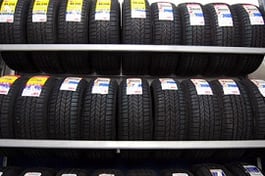 The next few years look like they will be good ones for tire stores ready to handle a widening array of tire manufacturers, the ever-expanding variety of rims and tire sizes (over 500 and counting), and the significantly different buying patterns of the post-recession customer.
The next few years look like they will be good ones for tire stores ready to handle a widening array of tire manufacturers, the ever-expanding variety of rims and tire sizes (over 500 and counting), and the significantly different buying patterns of the post-recession customer.
There’s a pent-up demand for tires, and industry experts expect that 2014 will be the year it begins to turn into revenue. Last year tire stores sold 201 million replacement tires, not far off the 2005 peak of 205 million and 5% more than in 2012. That helps explain why Modern Tire Dealer magazine’s 2013 State-of-the-Industry survey found that tire store owners expected their revenue to increase almost 10% this year. So far they look to be right. Despite the fiercely cold winter that depressed sales across the tire market – except for the one product you’d expect to do well: snow tires – tire sales since then have already shown a 2% increase over last year.
Manufacturers certainly expect the market to remain robust. Michelin and Bridgestone have each invested hundreds of millions in new capacity not only to meet demand but to prepare for the arrival of a much more competitive market. Kumho, Yokohama, Hankook and Toyo all have factories coming online in the US in the next couple of years. While the end of the tariff in 2012 has something to do with this, the bigger reason may be the changes to the American car fleet.
Americans are driving the oldest fleet of cars ever – 11.4 years old on average – and are more inclined to repair and maintain an older vehicle, with the number of vehicles twelve years or older expected to increase 12% over the next three years. The overall size of the fleet may increase to 260 million by 2018. Simply put, there are a great many more cars and trucks than there used to be.
And they’re all different. Not only must tire stores be ready to deal with these older cars, but they must also know how to handle the new and bigger aluminum alloy rims that have thin tires, high rolling coefficients, and a tendency to be damaged by potholes. While a damaged rim might look like a nice bit of business to the shop owner, some of these rims can cost $750+ each, so to the customer it could look like a significant unexpected expense.
Closing deals like that is where the rubber will hit the road for tire stores over the next few years.
Big box stores, online retailers and dealerships have already cut into your business, with auto dealerships alone more than doubling their share of the market in the last ten years. One reason is that some consumers are more interested in price than quality, but that customer probably goes directly to the big box or the online retailer.
The customer that comes into your store may be price conscious, but when a tire industry study shows that nearly 88 percent of tire repairs are performed improperly she might also be there because she wants professional service that won’t void her warranty or put her in danger.
She may also want service that won’t put her in debt. Post-recession, the prevalence of credit cards has dropped by nearly 64% and Americans have reduced their outstanding debt by $1.3 trillion, so if you’ve had the impression that people are less willing to pull out their credit card for a large expense, you’re right. And if she won’t finance the purchase on her card, she probably won’t be interested if you offered to finance it yourself.
Your job is to make sure she doesn’t walk out to search for a small discount that may make the purchase affordable. You have two primary tools to accomplish this.
The first is your incentive-based loyalty program. Start by explaining why she should be loyal: tires are critical to her driving safety, you have the expertise and experience to do the job right, and you have the highest value products available. Then offer her the incentive: a key chain or a punch card for a free oil change or other maintenance, and offer to punch halfway through it as an incentive to close the deal.
She’ll appreciate it, but it won’t work if she doesn’t have the funds today and she won’t use her credit card. So pull out your second tool: a multiple check service. Let her write two to four checks to be deposited over the next thirty days so she can get her purchase today and pay for it in synch with her cash flow.
From her point of view, she gets a better product, she gets to do business with the local expert, she gets the peace of mind that goes along with that – and she gets a loyalty key chain that’s already half-way to a free service.
From your point of view you get the sale and, depending on the check processing service you choose, each of her checks may be guaranteed so even if one bounces your cash flow won’t suffer. And perhaps you even acquired a new long-term customer and the recurring revenue and referrals that go along with it. So make sure you’ve got all the tools you need to take advantage of the better days ahead. Learn more here.



